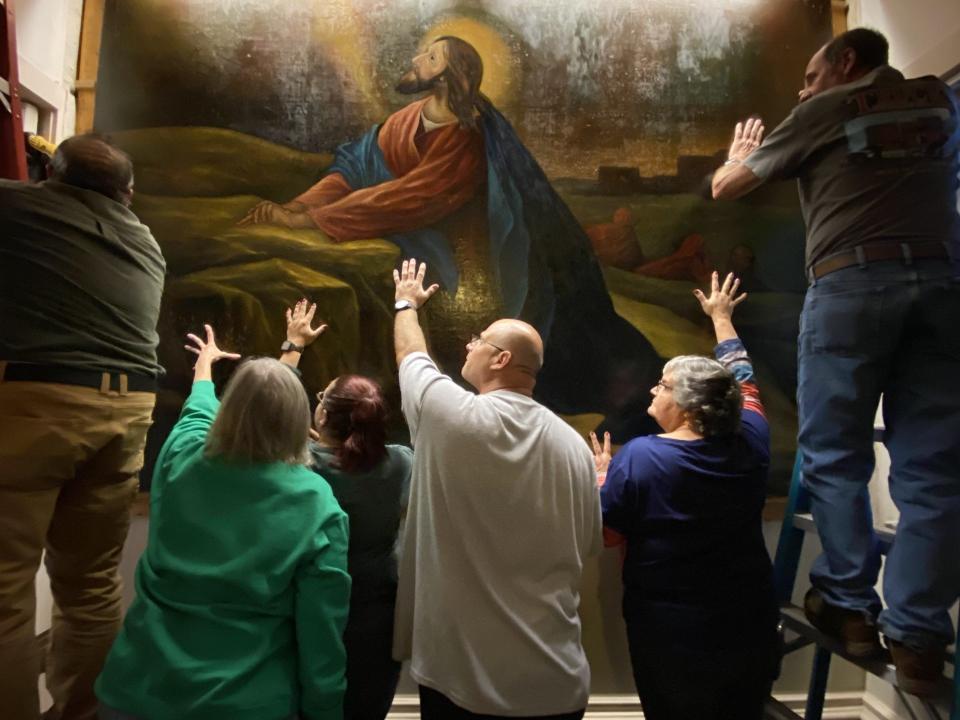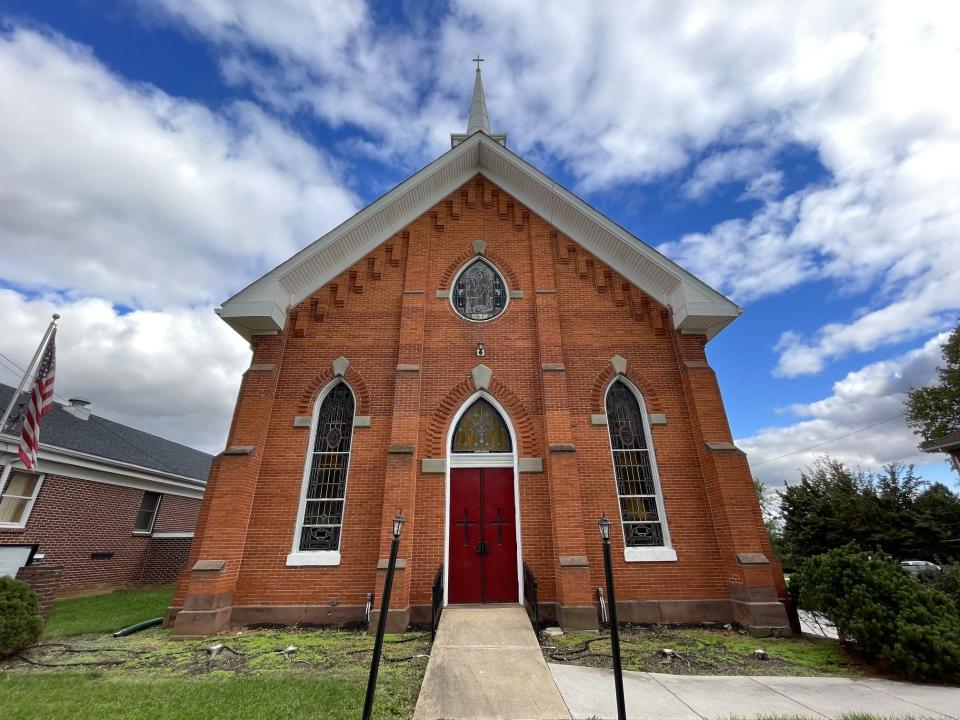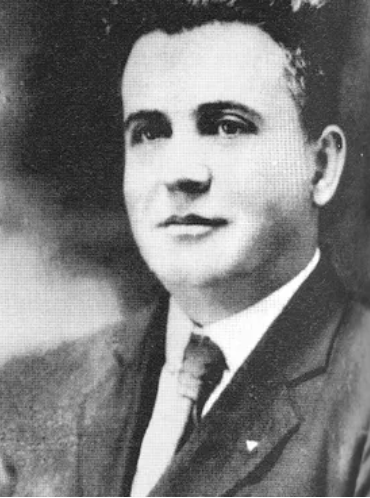Engaging Shrewsbury church painting helps bind two congregations
A crew worked thoughtfully to dismount and lower a large painting of Jesus from the wall behind the pulpit at St. Paul United Church of Christ in Shrewsbury.
It was a big job, moving the colorful, life-size painting of Jesus praying in the Garden of Gethsemane at nighttime, complete with his disciples sleeping in the background.
As the team did their work, they quipped — or maybe they were serious: “Everyone is insured, right? and “What we need is a rigger.”
A man with a hand tool prepared to remove the final screw affixing the 6-by-9-foot framed painting to the wall, bringing the comments: “Last screw.” And then, “Is that anything like the last straw?”
St. Paul members were in the crew. Or perhaps we could say those who formerly worshiped in the 151-year-old building.
Congregants met in their last service in June, and many now worship at New Hope Fissel’s United Church of Christ about 10 miles away.
So for some, the removal and rehoming of the unsigned Gethsemane painting positioned on the chancel wall was part of the journey of breaking up their church home — a milestone with a bit of closure.

A pastor and famous congregant
A lot happened at St. Paul church over the years.
One preacher behind St. Paul’s pulpit was well known in the community: Charles Mitzell, who pastored the church from 1924 until retirement in 1947. Given the short tenure of pastors, to stand in the pulpit so long meant that he had ability and did his job well.
Indeed, in the Great Depression, he volunteered to take more than one pay cut, the last one of $300 coming in 1938.
He was also known beyond the Shrewsbury community. He was involved in local theater, for example, cast to star in the York Little Theatre’s rendition of “Inherit the Wind” in 1958. But he became ill and could not perform in this rendition of the Scopes Monkey Trial in Dayton, Tennessee, about 30 years before.
Fortunately, he had an understudy of a kind. Of the best type, we should say.
One of his seven children, Cameron, stepped into his role and pulled it off with applause. Cameron had a bit of experience in playing roles.
Cameron Mitzell, stage name Cameron Mitchell, is the most accomplished actor York County ever produced. He performed in more than 150 movies and is best known as “Uncle Buck” on the TV series “High Chaparral.”
Cameron (1918-1994) grew up in St. Paul’s congregation. In giving a eulogy for his brother, Carlisle, at the church years later, he pointed out his perch to hear his father preach: in the upper left part of the church’s balcony. He had a penchant for depositing his chewing gum under the seats in that section.
The Cameron Mitchell tale is a good one, and a congregation that old would accumulate many stories.
There’s one that connects with Camp Stewartstown, the German prisoner of war camp that took its name from the nearby town east of Shrewsbury.
Two members of St. Paul had regular contact with these World War II prisoners, who worked in canneries, orchards and farms in the region.
Alvin Shaub hired some of the men to work on his farm. And Alvin’s brother, Dr. Paul Shaub, was the camp physician.
In 1989, Alvin’s son, Robert, and Robert’s wife, Margaret, located former POWs in Europe and invited them to tour the old Stewartstown camp site near the Presbyterian church. And the former prisoners attended a Sunday service at St. Paul, even singing a German hymn.

St. Paul’s story indicates change
The baby boom spawned St. Paul’s growth in the 1960s and 1970s.
St. Paul and other Shrewsbury congregations attracted newcomers to the region with the opening of Interstate 83 in 1959, a moment in York County’s story that some call the “Maryland migration.”
But St. Paul’s congregation started to decline in numbers in the 1980s. A congregational history, published in 2022, attributes the loss to a national decline in church attendance and an increasing number with no affiliation.
Indeed, a recent study shows that 40 million adult Americans of all religious stripes have dechurched in the past 25-30 years, meaning they no longer attend services. According to researchers, that’s the largest and fastest religious shift in American history.
Further, in York County and elsewhere, large independent churches with an array of ministries have attracted former congregants of the “mainline churches” — United Church of Christ, Lutheran, Methodist, Episcopal and Presbyterian. Congregants have left these churches, too, because of their national affiliates’ liberal stands on social issues.
And individual congregations have left their former denominations and created new ones or have stayed independent. For example, by one count, about 30 churches in York County have “disaffiliated” from their longtime United Methodist parent.
Members at St. Paul weathered the pandemic, another influence that impaired American religious worship and passed their 200th anniversary in 2022.
But members voted to close down earlier this year, combining with Fissel’s.
That was a decision that brought tears.
The congregation, Pat Bonner said, just couldn’t do it financially.
Bonner’s connection with St. Paul typifies many of its members. She was baptized and grew up in the church. In 1971, she was the first Girl Scout at the church to receive the God and Country Award.

St. Paul’s vintage painting
All this brings us back to the painting.
Until recently, C. Guy Stambach was believed to have been the artist whose brush created the Gethsemane scene. And maybe he was. Stambaugh, a United Brethren pastor (later United Methodist), painted biblical scenes at scores of houses of worship in York County and the region.
Stambach used the masters as a source for his paintings. For example, he accessed German artist Heinrich Hoffmann’s famed rendition of Jesus in Gethsemane.
The masters inspired another York County painter of scores of biblical scenes, sometimes called church decorations. About 1950, Roth Brothers, 936 E. Princess St. in York, published a list of houses of worship where artists did their work. They listed the United Methodist and Lutheran churches in Shrewsbury.
But not a painting in St. Paul.
For many months, Bonner credited Stambach with the St. Paul chancel scene, basing this on a nearly identical painting in Windsor Township’s Zion United Methodist Church. She based this on pictures in an online story in the York Daily Record.
Now, after comparing the work of Stambach and the Roth Brothers, she’s not certain who rendered St. Paul’s scene. The colors used by the signed Roth Gethsemane scene in Paddletown St. Paul’s Church, for example, better match the colors at St. Paul in Shrewsbury. And St. Paul member, Gary Klinedinst, has recently found a Gazette and Daily news article from May 1944 that states the interior of the Shrewsbury church had just recently been decorated by the Roth Brothers.
Stambach usually signed his work, and the Roth Brothers put their name on the Paddletown painting, but none could be found on the St. Paul painting.
Thus, the puzzle.
Either way, York County, long the land of artists going back to Lewis Miller and William Wagner in the 1800s, was home to two leading painters of religious art in the region in the first half of the 20th century. Given the prominence of their religious art, their paintings have been viewed by more people than any other artist in the county’s long history.
And either way, the St. Paul Gethsemane scene is significant. Three other congregations have expressed an interest in hanging it in their church building. It will be moved to a new home before the new owner of St. Paul’s building, the nearby Freedom Community Church, moves in.
Painting helps join congregations
The other evening at St. Paul, those assembled accomplished their mission without mishap, successfully lowering the painting to the floor. They let it sit there with a mop handle under one end to allow the new owner to more easily get a hold on its base. No use in risking damage by moving it more.
The painting required a small squad just to lower it. But this was more than a moving job. The St. Paul members were joined by those from the New Hope Fissel’s congregation. It was another way to welcome St. Paul congregants to their new church family.
The St. Paul congregants, Bonner said, could not have handled the weighty job on their own. But the two congregations, acting as one, got the job done.
“Fissel’s has been exceptional in how its congregation has helped us respectfully close the church that has been our home for so many years,” Bonner said. “St. Paul members feel blessed to have such a warm and welcoming new home.”
Jesus, in the form of paint on canvas in Gethsemane and present in other ways, had brought them together.
Sources: York County History Center files; York Daily Record files; St. Paul United Church of Christ’s booklets, “150th Anniversary” and “Celebrating 200 Years”; Good Faith podcast “The Great Dechurching.”
Jim McClure is a retired editor of the York Daily Record and has authored or co-authored nine books on York County history. Reach him at jimmcclure21@outlook.com.
This article originally appeared on York Daily Record: Shrewsbury, Pa. church painting helps bind two congregations

